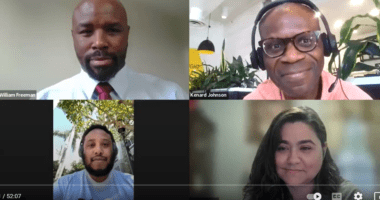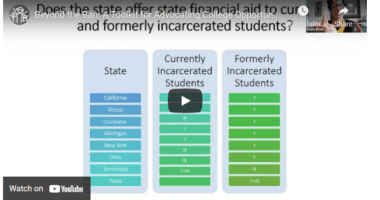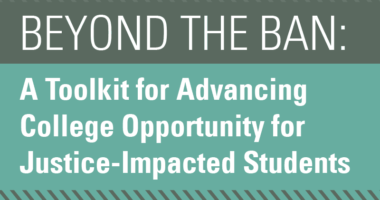William Freeman III, The Education Trust Justice Fellow, Written Testimony on Implementing Pell Grant Eligibility for Students Who Are Incarcerated
Vanessa Gomez
U.S. Department of Education
400 Maryland Avenue SW, Room 2C179
Washington, DC 20202
Re: Docket ID ED-2021-OESE-0077
Dear Ms. Gomez,
Thank you for the opportunity to provide written public comment regarding the U.S. Department of Education’s (the Department) plans to engage in rulemaking across a host of higher education topics. My comments focus on the Department’s implementation of Pell Grant eligibility for students in prison education programs.
I experienced the transformative power of in-person college classes, as a former Goucher Prison Education Partnership (GPEP) student. GPEP classes created a neutral safe space where we could share deeper aspects of ourselves as intelligent people (and be acknowledged for it) apart from a degree as an outcome. I am a first-generation college graduate student currently enrolled in a full-time MPH student at the Johns Hopkins Bloomberg School of Public Health.
I was pleased to see Congress lift the 1994 ban on the use of Pell Grants by students who are incarcerated in the December 2020 COVID-19 relief package. That law contains specific provisions that allow the Department to implement Pell restoration early, prior to 2023.
I urge the Department to act quickly to implement Pell Grants for students who are incarcerated this year, 2021, while establishing safeguards to ensure that earning a higher education in prison pays off for students and for taxpayers.
Until you fully restore Pell Grants for incarcerated students, more than 400,000 eligible students in prison – many of them from Black and Latino communities disproportionately affected by incarceration and many who were denied equitable access to essential educational opportunities all their lives – will remain locked out of higher education opportunities.
It is important that you issue guidance to reinstate Pell for students in prison, rather than go through the negotiated rulemaking process, for the following reasons:
- Fewer carceral education programs means fewer justice-impacted individuals have access to essential educational opportunities. It means more individuals reengaging with the criminal justice system, higher incarceration costs, and continued community trauma, especially among Black and Latino communities disproportionately affected by incarceration. It also means delaying additional progress on addressing racial disparities in college attainment overall, which is an ongoing goal of the Department of Education.
- The Second Chance Pell Experimental Sites Initiative proved that colleges can successfully ramp up quality higher education programs for students in prison. Given the Department’s existing experimental sites, effective models are already in place to facilitate quick and efficient implementation. Existing frameworks for approval and reporting established by the Department can be repurposed in guidance to ensure that existing programs can expand responsibly and new programs can begin operating with fidelity.
- As you know, Pell Grant eligibility for students in prison education programs has support across the political spectrum. The Education Department launched the Second Chance Pell Experimental Sites Initiative under the Obama administration and expanded it under the Trump administration. A wide range of stakeholders – including education and criminal justice advocates, think tanks, business leaders, faith-based organizations, and state departments of corrections teamed up to push Congress to lift the ban. The public reached consensus, Congress acted, and now it’s up to the Department to implement this policy.
Through guidance outside of the negotiated rulemaking process, the Department should address several important issues related to program integrity and quality to ensure that students and taxpayers are protected when Pell Grant eligible prison education programs for students who are incarcerated are implemented.
Prison education programs should only be eligible to administer Pell Grants if they:
- Offer students who are incarcerated the same opportunities for academic and career advising and counseling, as well as consistent access to programmatic information, that students who are not incarcerated receive;
- Ensure that the cost of the program does not exceed the value of the Pell Grant or other funding the institution may have received to support that program, and that no tuition, debt, fees, or other charges are passed on to the enrolled student in the form of out-of-pocket payments or loans that must be repaid;
- Facilitate students’ future career and educational goals through articulation agreements, transferability of credits, and admission and comprehensive support services for students;
- Partner with local, community-based organizations with documented reentry success, to work together on comprehensive, full-service reentry programs;
- Identify ways to absorb the costs of transcript fees, since most students who are incarcerated are not in a financial position to pay for an official transcript;
- Understand the challenges of operating effective distance-education or correspondence programs for students who are incarcerated, and prioritize access to established face-to-face programs over the provision of solely asynchronous content;
- Build in enough time for students who are incarcerated to gather the necessary documentation for filing a FAFSA and overcome common hurdles to completing the application, and prohibit enrollment practices that give priority to students based on years to reentry or their probability of obtaining the documentation needed to fill out a FAFSA; and
- Assist students who have defaulted on federal student loans to rehabilitate those loans, so they can be eligible for federal student aid, and help ensure that students who are incarcerated are included in any student debt cancellation policies implemented by the administration or Congress.
I appreciate the opportunity to comment and your attention to this important issue.
Thank you,
William G Freeman III





